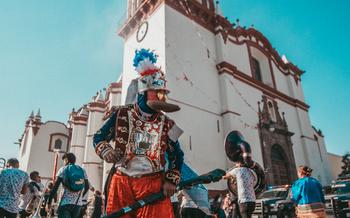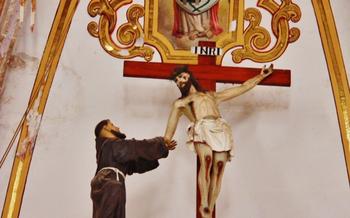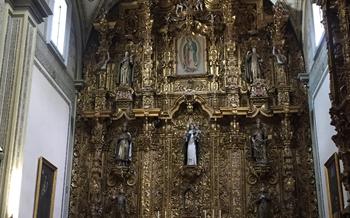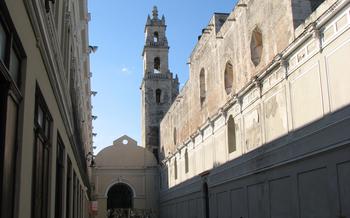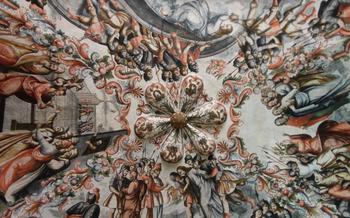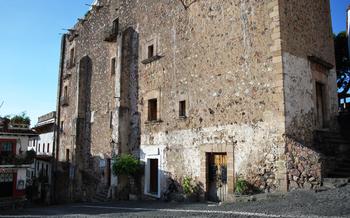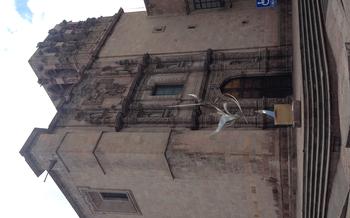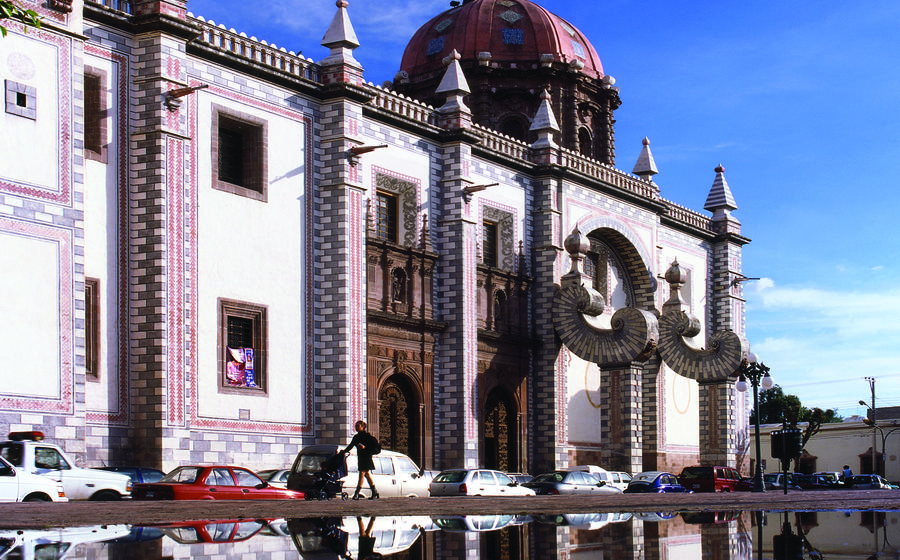
Temple of Santa Rosa de Viterbo
- The Founding and Construction of the Temple:
- Location and Getting There:
- Religious Significance
- Interior Treasures
- Visiting Hours and Admission:
- Dress Code and Respectful Behavior
- Explore the Surrounding Area:
- Attend a Religious Service: Witnessing Faith and Devotion
- Photography and Capturing Memories
- Local Festivals and Celebrations
- Local Crafts and Souvenirs:
- Accessibility for Visitors with Disabilities
- Insider Tip:
The Founding and Construction of the Temple:
In the heart of Queretaro, Mexico, stands the magnificent Temple of Santa Rosa de Viterbo, a testament to the city's rich religious and architectural heritage. Its story begins in the 17th century when the Augustinian Order, a Catholic religious order, arrived in Queretaro with the mission of spreading Christianity. Inspired by their devotion to Saint Rose of Viterbo, an Italian saint known for her piety and miracles, they set out to build a temple in her honor.
The construction of the temple commenced in 1725, and over the following decades, it underwent various stages of expansion and embellishment. The Augustinian friars, skilled architects and builders, meticulously crafted the temple using local materials, including the distinctive pink sandstone that characterizes many of Queretaro's historic buildings.
The result of their labor is a stunning masterpiece of Baroque architecture, showcasing intricate carvings, ornate decorations, and an awe-inspiring facade that tells the story of Saint Rose's life and her devotion to God. The temple's grandeur and beauty quickly made it a symbol of Queretaro, attracting pilgrims and visitors from across the region.
Location and Getting There:
The Temple of Santa Rosa de Viterbo stands majestically in the heart of Queretaro, Mexico, at the Santiago de Querétaro, Qro. Reaching the temple is a breeze, whether you're navigating by car or relying on public transportation.
For those driving, there are ample parking spaces available in the vicinity. However, finding a spot during peak tourist season might require some patience. Alternatively, you can hop on the efficient public transportation system. The temple is well-connected by buses, making it easily accessible from various parts of the city.
Once you arrive in the area, simply follow the signs or ask for directions to the temple. Its iconic facade and prominent location make it hard to miss. Be prepared to be captivated by its architectural grandeur as you approach this sacred site.
Religious Significance
The Temple of Santa Rosa de Viterbo holds immense religious significance for the Catholic community in Queretaro. It is dedicated to Saint Rose of Viterbo, a 13th-century Italian saint known for her devotion, charity, and miraculous abilities. The temple serves as a place of worship, pilgrimage, and spiritual connection for the faithful.
Religious ceremonies and services are held regularly at the temple, including masses, novenas, and special devotions dedicated to Saint Rose. During these services, worshippers gather to pray, sing hymns, and seek blessings. The temple is also a popular destination for pilgrims who come from near and far to pay homage to Saint Rose and ask for her intercession.
The temple's significance as a pilgrimage site is further enhanced by the belief that Saint Rose has performed miracles and answered prayers. Devotees often leave offerings and petitions at the altar, seeking her divine assistance in various aspects of their lives. The temple's walls are adorned with numerous plaques and ex-votos, which serve as testaments to the answered prayers and blessings attributed to Saint Rose.
Interior Treasures
The Temple of Santa Rosa de Viterbo is adorned with a wealth of interior treasures that reflect its religious significance and artistic heritage. The main altarpiece, dedicated to Saint Rose of Viterbo, is a breathtaking masterpiece of Baroque art. Intricately carved and adorned with gold leaf, it depicts scenes from the saint's life, including her miracles and her devotion to God.
The temple also houses a collection of religious paintings, sculptures, and artifacts that are both awe-inspiring and historically valuable. These works of art showcase the talent of local artisans and the artistic traditions of Queretaro. From delicate sculptures of saints to vibrant paintings depicting biblical scenes, each piece contributes to the temple's rich visual tapestry.
Ornate carvings, frescoes, and stained glass windows adorn the temple's interior, adding to its grandeur and beauty. The intricately carved choir stalls, featuring intricate designs and biblical figures, are a testament to the skill and artistry of the craftsmen who created them. The frescoes, depicting scenes from the life of Christ and the saints, add a touch of divine inspiration to the temple's atmosphere.
Finally, the temple houses several historical relics and sacred objects that hold deep significance for the Catholic community of Queretaro. These treasures include relics of Saint Rose of Viterbo, such as a portion of her veil and a fragment of her bone. The presence of these relics adds a tangible connection to the saint and enhances the spiritual aura of the temple.
Visiting Hours and Admission:
The Temple of Santa Rosa de Viterbo welcomes visitors with open arms, inviting them to explore its sacred spaces and witness its architectural splendor. Its doors are open from Monday to Sunday, between the hours of 7:00 AM and 8:00 PM. Devotees and tourists alike can freely enter the temple during these hours, immersing themselves in its serene atmosphere and marveling at its intricate details.
Admission to the temple is free of charge, allowing everyone to experience its beauty and spiritual significance without any financial barriers. However, donations are gratefully accepted and contribute to the preservation and upkeep of this architectural masterpiece. Visitors are encouraged to support the temple's efforts to maintain its grandeur for generations to come.
Guided tours are available upon request and can be arranged through the temple office. These tours provide an in-depth understanding of the temple's history, architecture, and religious significance. Knowledgeable guides share fascinating stories and anecdotes, bringing the temple's past to life and enriching the visitor experience.
To fully appreciate the temple's tranquility and avoid the hustle and bustle of crowds, it is advisable to plan a visit during off-peak hours. Early mornings or late afternoons offer the most serene and intimate atmosphere, allowing visitors to connect with the temple's spiritual essence without distractions.
Dress Code and Respectful Behavior
When visiting the Temple of Santa Rosa de Viterbo, it is essential to dress respectfully, as it is a sacred space for worship and contemplation. Conservative attire that covers the shoulders and knees is recommended, and shorts, tank tops, or revealing clothing should be avoided. Visitors should also be mindful of their noise levels and avoid talking loudly or engaging in disruptive behavior that may disturb worshippers or other visitors. Photography is permitted, but it is important to be respectful and avoid using flash or capturing images of individuals without their permission. By following these guidelines, visitors can show respect for the local community, preserve the sanctity of the temple, and fully appreciate its beauty and history.
Explore the Surrounding Area:
Strolling beyond the Temple of Santa Rosa de Viterbo reveals a treasure trove of attractions that invite exploration. Within easy walking distance, visitors can immerse themselves in Queretaro's rich history and vibrant culture. The Museo Regional de Queretaro, housed in a former convent, showcases intriguing artifacts and exhibits that narrate the city's captivating past. The Templo de San Francisco, with its Gothic-style architecture, stands as a testament to Queretaro's religious heritage.
For those seeking a taste of local flavor, the Mercado de la Cruz, a bustling market, offers an array of traditional Mexican delicacies, handicrafts, and souvenirs. Art enthusiasts can revel in the Museo de Arte de Queretaro, which houses a diverse collection of contemporary and classical artworks.
To fully embrace Queretaro's essence, savor the delectable cuisine at local restaurants, where tantalizing aromas waft from kitchens serving up authentic Mexican dishes. Quaint cafes beckon with their inviting ambiance, offering a respite amidst the city's vibrant energy.
Craft a personalized itinerary that harmonizes with your interests, whether it's delving into history, appreciating art, indulging in culinary delights, or simply wandering the charming streets, soaking in the city's unique atmosphere.
Attend a Religious Service: Witnessing Faith and Devotion
Beyond its architectural wonders, the Temple of Santa Rosa de Viterbo invites visitors to immerse themselves in the spiritual heart of Queretaro by attending a religious service. The church offers a daily schedule of masses and services, providing an opportunity to witness the devotion and traditions of the local Catholic community. Before attending, it is important to dress respectfully and observe local customs. Respectful behavior includes maintaining silence during the service, avoiding distractions, and refraining from photography. Participating in a religious ceremony at the temple offers a unique atmosphere and spiritual experience, allowing visitors to connect with the faith and traditions of the people of Queretaro. The solemn chants, the scent of incense, and the fervor of the congregation create a powerful and moving experience that will leave a lasting impression.
Photography and Capturing Memories
When visiting the Temple of Santa Rosa de Viterbo, capturing the beauty and grandeur of the architecture through photography is a must. However, it's essential to be respectful of the religious nature of the site and follow guidelines to ensure you don't disturb worshippers or disrupt the sacred atmosphere. Here are some tips for photography enthusiasts:
-
Be Mindful of Your Surroundings: Be aware of your surroundings and avoid blocking walkways or causing inconvenience to visitors and worshippers. If a religious service is ongoing, step aside to let people pass and avoid taking photos that might disrupt the proceedings.
-
Ask Permission: Before photographing individuals within the temple, it's polite to ask for their permission. This shows respect for their privacy and ensures that you're not capturing anyone who might not want their photo taken.
-
Respect the Sanctity of the Space: While taking photos, be mindful of preserving the sanctity of the temple. Avoid using flash photography, as it can be disruptive and disrespectful during religious services.
-
Capture Unique Details: Look for unique details and perspectives that showcase the temple's beauty. The intricate carvings, frescoes, and stained glass windows are all worthy of capturing. Try different angles and compositions to create captivating shots that tell a story.
-
Share Responsibly: When sharing your photos online, be sure to tag the Temple of Santa Rosa de Viterbo's social media accounts to give credit and help promote this magnificent landmark. This allows others to appreciate the beauty of the temple and encourages them to visit this sacred site.
Local Festivals and Celebrations
The Temple of Santa Rosa de Viterbo is not only a historic and architectural marvel; it is also a vibrant center of religious festivities and celebrations throughout the year. The most prominent event is the annual feast day of Saint Rose of Viterbo, celebrated on September 4th. During this grand occasion, the temple becomes a hub of activity and devotion, attracting pilgrims and visitors from near and far.
The festivities commence with a solemn mass in the morning, followed by a colorful procession that winds its way through the streets of Queretaro. Devotees carry the statue of Saint Rose, adorned with flowers and offerings, accompanied by traditional music and dancing. The procession culminates at the temple, where a special mass is held in her honor.
Throughout the day, the temple square transforms into a lively fair, filled with food stalls, music, and entertainment. Locals and visitors alike indulge in traditional delicacies, enjoy live performances, and soak in the festive atmosphere. The celebrations offer a unique glimpse into the vibrant religious traditions of Queretaro and provide an opportunity to experience the city's cultural heritage firsthand.
Tips for Experiencing the Local Festivals:
-
Plan your visit to Queretaro to coincide with the feast day of Saint Rose of Viterbo (September 4th) to fully immerse yourself in the festivities.
-
Arrive early to witness the procession and secure a good spot for viewing.
-
Dress respectfully and observe local customs during the religious ceremonies.
-
Sample the delicious local cuisine and enjoy the vibrant atmosphere of the fair.
-
Engage with the locals, learn about their traditions, and share in their joy and devotion.
Local Crafts and Souvenirs:
Strolling through the cobblestone streets surrounding the Temple of Santa Rosa de Viterbo, visitors will stumble upon charming shops and stalls brimming with religious artifacts, traditional handicrafts, and unique souvenirs. These local treasures, inspired by the temple's architecture, history, and patron saint, provide a tangible connection to the spirit of Queretaro.
From intricately carved wooden figurines depicting Saint Rose of Viterbo to colorful hand-painted ceramics adorned with scenes from the temple's history, these souvenirs offer a glimpse into the rich cultural heritage of the region. Visitors can also find beautifully crafted rosaries, candles, and other religious items, each imbued with a sense of devotion and spirituality.
Supporting local artisans by purchasing their handcrafted creations not only ensures the preservation of traditional crafts but also contributes to the vibrant economy of the community. These artisans pour their heart and soul into their work, ensuring that each piece is unique and carries a story.
Whether seeking a meaningful memento of your pilgrimage or simply a cherished reminder of your time in Queretaro, the local crafts and souvenirs surrounding the Temple of Santa Rosa de Viterbo offer an authentic and unforgettable way to commemorate your visit.
Accessibility for Visitors with Disabilities
The Temple of Santa Rosa de Viterbo is committed to ensuring accessibility for all visitors, regardless of their abilities. The temple features several modifications and accommodations to cater to individuals with disabilities. Wheelchair ramps have been installed at the main entrance, allowing easy access to the temple's interior. Within the temple, designated seating areas are available for those with limited mobility. Visitors with hearing impairments can request assistive listening devices to enhance their participation in religious services. For individuals with visual impairments, tactile maps and audio guides are provided to help them navigate the temple's layout and learn about its history and significance. By offering these accessibility features, the temple creates a welcoming and inclusive environment for all visitors, allowing them to fully appreciate the beauty and spirituality of this sacred space.
Insider Tip:
Beyond the grandeur of its architecture and religious significance, the Temple of Santa Rosa de Viterbo holds hidden gems that offer a unique glimpse into its charm and history. For photography enthusiasts, venture to the rooftop terrace, where you can capture breathtaking panoramic views of the city and the temple's intricate dome. Here, the play of light and shadow creates an ethereal atmosphere, transforming the temple into a true masterpiece. And as you stroll along the temple's perimeter, don't miss the small garden tucked away behind the apse. This serene oasis features a hidden fountain adorned with colorful tiles, offering a tranquil spot for reflection and contemplation. Let the beauty of this hidden gem transport you to a world of peace and serenity.

